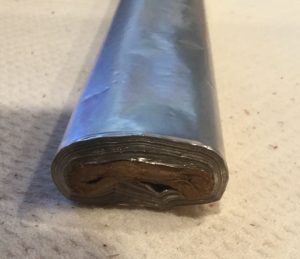Posted on: 26th July 2019 by Private: Alison Arrowsmith
Here at Innoval Technology, we receive an array of enquiries into our inbox. Some are straightforward, some are challenging, and some are very intriguing. One enquiry which fits into the ‘intriguing’ category involves a curious tale concerning a canoeing trip and a roll of wet aluminium cooking foil.
To set the scene, our story takes place along the Arkansas River Trail, USA. Our enquirer is enjoying a few days’ holiday, canoeing downstream and stopping off to make camp along the way. Amongst his camping gear and supplies is that essential and ubiquitous survival staple; a roll of aluminium cooking foil.
What happened?
On the day in question, whilst paddling along the river, our explorer hit a rapid, flipping his canoe over. This drenched everything on board, including the half-used roll of aluminium cooking foil. Although the roll was soaked, our enquirer considered it still usable. He decided to discard the outer cardboard carton and store the roll in a dry bag with some clothing while he continued his trip down river.

After a few hours of travel, with the bag in direct sunlight, our enquirer stopped to camp and was amazed to hear the sound of hissing coming from the dry bag. On opening the bag, he discovered the aluminium cooking foil roll to be extremely hot. In fact, there was steam coming from the wet inner cardboard cylinder!
Our camper was perplexed and more than a little concerned as to why this was happening. The bag was made from a bright yellow waterproof vinyl fabric. There were no electronics inside and the air temperature was about 30oC.
Why was the aluminium cooking foil so hot?
Here is the explanation from our Senior Consultant and aluminium foil expert, Vicente Martin:
First of all, let’s consider the science. Although aluminium does not rust, it is a very reactive metal. However, the natural oxide formed is very effective in preventing the progress of further oxidation. This is why it is so effective in outdoor and demanding applications. But that doesn’t mean that it is impervious to corrosion under the right circumstances.
Oxidation of aluminium in water follows the following possible reactions:
- 2Al + 6H2O = 2Al(OH)3 + 3H2
- 2Al + 4H2O = 2AlO(OH) + 3H2
- 2Al + 3H2O = Al2O3 + 3H2
So, aluminium metal can react with water forming an aluminium oxide or hydroxide and releasing hydrogen gas. The three reactions are highly exothermic, generating at least 270 kJ/mol of heat.
The action of salt
In normal circumstances, the oxide prevents the continuation of the reaction. However, the presence of salts helps break the continuity of the oxide layer allowing corrosion to proceed. Usually this is a very slow process.
In our intrepid camper’s case, he had a roll of foil of 16 micrometres (0.63 mils) with a lot of exposed surface fully soaked in water. Usually, water (even fresh) contains salts which help to break the protective oxide layer. This exposes fresh aluminium metal to react further, creating a continuous and fast reaction that generates heat and hydrogen over a very large surface. Furthermore, it was a hot day, which would have caused the reaction to speed up.
Consequently, our enquirer had a small reactor in his hands! This hydrogen generation can build up enough pressure to blow an industrial coil apart. In fact, this has happened in foil plants where flooding has soaked large coils.
In this case, the aluminium cooking foil roll was small (so there was less area for reaction), and not tightly wrapped. Thankfully, the hydrogen escaped with a hissing sound rather than generating a small explosion.
Don’t worry!

Our consultants have never heard of anyone being injured by this phenomenon.
We believe our enquirer was safe and you should have no qualms in packing your aluminium cooking foil for when you’re out and about. However, we would suggest avoiding using an airtight bag to store a soaking wet roll!
A big thank you to our enquirer who gave us permission to re-tell his story, as well as use the photo of the soaked roll.



